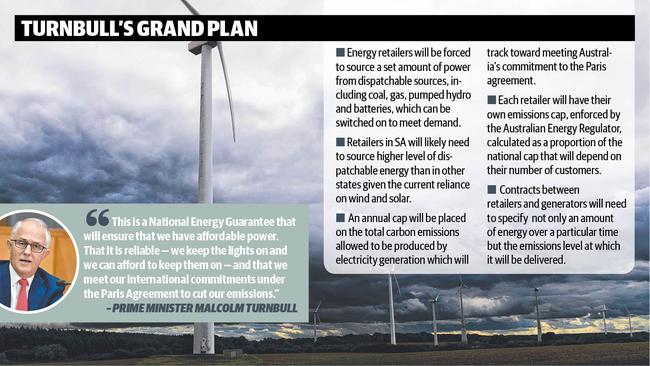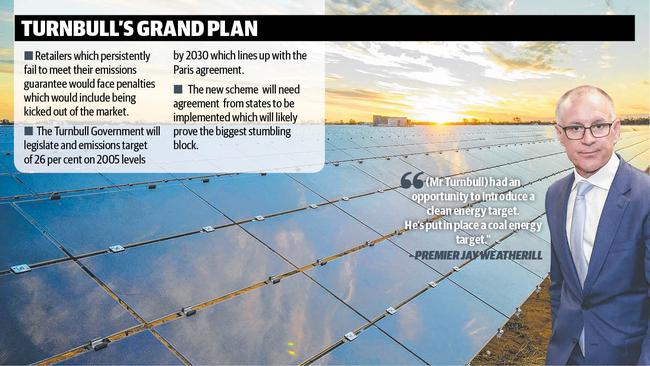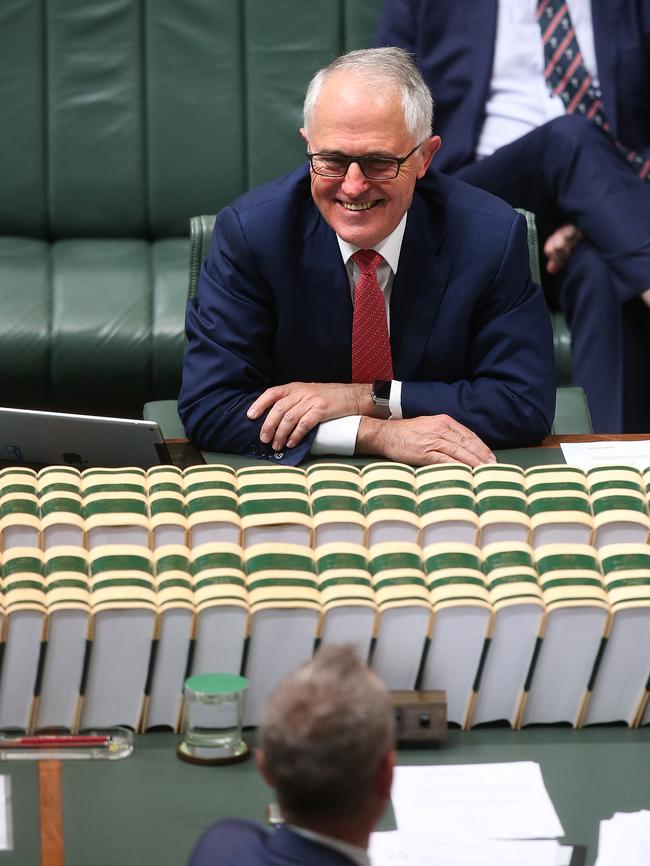SA ideal place to test Federal Government’s energy plan to cut power bills, experts say
SOUTH Australia’s long history of electricity woes makes it the ideal guinea pig for the Turnbull Government’s new plan to cut power bills and prevent blackouts, the scheme’s architects believe.
SA News
Don't miss out on the headlines from SA News. Followed categories will be added to My News.
- Turnbull unveils ‘affordable, reliable’ energy strategy to cut bills
- New targets for energy giants after Govt dumps renewables subsidies
- PM ‘shirt-fronted’ Abbott on energy
- SPECIAL REPORT: What you need to know about SA’s power crisis
SOUTH Australia’s long history of electricity woes makes it the ideal guinea pig for the Turnbull Government’s new plan to cut power bills and prevent blackouts, the scheme’s architects believe.
Coalition MPs on Tuesday gave Prime Minister Malcolm Turnbull the green light to put in place a new energy policy.
It will axe renewable subsidies and force power retailers to source “reliable” electricity.
Modelling showed the National Energy Guarantee (NEG) would save households about $115 a year on average over a 10-year period but it could be as little as $25 in the first year in 2019 before the savings ramped up.
It would also allow Australia to achieve its commitment of a 26-28 per cent reduction in 2005 emissions by 2030.
While the move was generally welcomed by business and industry, the Labor Opposition and state governments were not convinced and said their crucial support would depend on more detail.
In advice handed to Energy Minister Josh Frydenberg, the scheme’s architect the Energy Security Board said: “An early introduction into SA could be considered given current concerns about reliability in that state”.



But Premier Jay Weatherill provided little hope that such a move would be accepted, criticising the plan as “a subsidy of the coal industry”.
Australian Energy Market Operator chief executive Audrey Zibelman revealed the regulator had been regularly intervening in the SA market to ensure the lights remained on, which had increased pressure on power prices.
“The issue that AEMO is most concerned about is keeping the lights on and what we’ve discovered through our experience in SA is when you get to certain levels of renewable intermittent generation (wind and solar), the system itself becomes less stable,” she said.
“Absent a mechanism like this (the NEG) ... AEMO is finding itself in the position that we actually have to direct generators to come online to provide that stability at the spot price, which is quite expensive.
“Recently, we’ve been intervening quite a bit.
“Particularly on weekends, we’re seeing very low levels of usage because of the level of photovoltaics and a lot of wind energy. So we’re actually intervening to put on gas energy to maintain the stability of the system.”
Mr Turnbull labelled the new policy a “game changer” and promised it would ensure Australians had affordable power.
“No more industry policy, no more picking winners, no more favouring one technology after another, but simply ensuring that we have a reliable energy system, that we keep the lights on, that we do so in a way that is affordable and, of course, we meet those international (emissions reduction) commitments,” he said.
The Energy Security Board told the Government that by 2030 it expected intermittent renewable generation such as wind and solar would make up about 18 to 24 per cent of total generation.
This has given rise to fears that power prices in SA may not be pushed down to the same extent as other states because wind and solar already made up about 50 per cent of local generation.
Australian Energy Market Operator chair John Pierce, who did the price modelling, said that the savings was based on analysis of alternative schemes.
He said fresh estimates would be provided in the next month that were specific to this new proposal.
Chief scientist Alan Finkel backed the new policy and denied it was a significant shift away from what he recommended.
“There are multiple ways of achieving a credible mechanism. I’m optimistic power bills will go down. We will see early wins on prices,” he said.
The nation’s energy ministers were given a briefing on the plan over the phone and will meet in November. The plan requires state agreement for it to be put in place.
Mr Weatherill accused Mr Turnbull of being “paralysed by the vested interests in his party room”.
“(Mr Turnbull) had an opportunity to introduce a clean energy target. He’s put in place a coal energy target,” he said.
Asked if State Governments should consider moving to implement a clean energy target themselves, Mr Weatherill said he would “certainly be discussing this with my state colleagues”.
Defence Industries Minister Christopher Pyne said Mr Weatherill simply wanted to pick a fight.
“The fault line is not between renewables versus coal. It’s between affordable reliable power versus blind ideology costing consumers and businesses money they haven’t got for power they can’t rely on,” he said.
Barker MP Tony Pasin, who had been critical of renewable subsidies, said there was overwhelming support among Coalition MPs for this plan.
“Like any approach it’s not perfect but it’s immeasurably better than a Clean Energy Target,” he said.
“It will deliver more affordable electricity to consumers rather than its priority being carbon abatement.”
Federal Opposition energy spokesman Mark Butler slammed the Government’s plan but did rule out coming to some agreement on it.
“I don’t think anyone understands what this policy means. We’ve had confirmed that there hasn’t even been detailed modelling about the impact on business, on households or the energy industry itself,” he said.
Senator Nick Xenophon said there could be some merit to this plan but he wanted to see the detail.
“My fear is the damage already been done. A series of bad decisions has left South Australia extra vulnerable because of the state’s energy mix,” he said.
AGL boss Andy Vesey, who has been locked in a fight with the Government over the closure of a NSW coal-fired power station, said the announcement an “important step”.
“Keen to work together to make it work. With bipartisan support, it will provide investment certainty,” he said.
Analysis — Malcolm crosses divide to find his energy
MALCOLM Turnbull’s face was plastered with a wide grin yesterday after he won consensus in his fractious party room on energy policy.
Making the victory that much more sweet, the heads of the four independent bodies which control the national grid sat alongside the Prime Minister as he announced the new scheme. It was no mean feat.
Then chief scientist Alan Finkel come out and endorsed the plan.
But the champagne was already going flat when state governments quickly jumped up to criticise it.
Then the afternoon phone briefing of state government energy ministers was more than a little testy. Without the states’ support there will be an uphill battle to implement the plan.
While there’s a long way to go Mr Turnbull’s biggest political challenge — the internal division — appears to be settled.
At least now his Government has an energy policy it can prosecute. The silence had been deafening.
If the plan does get up, Coalition MPs will have to cross their fingers bills do come down.
Voters will demand it and that party room harmony is unlikely to be long lasting without it.
Alternatively, if the states, Labor or the Greens block action, voters are unlikely to be happy with their all or nothing attitude.
— Sheradyn Holderhead


